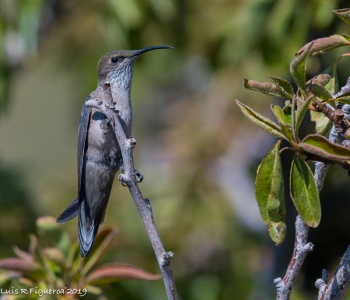(→Taxonomy: Update link) |
(All sections now started. Clearer female image. C/right. References updated. Incomplete gone) |
||
| Line 1: | Line 1: | ||
| − | {{ | + | [[Image:White-sided_Hillstar.jpg|thumb|550px|right|Male<br />Photo © by {{user|Fritz73|Fritz73}} <br />Purmamarca, Jujuy, [[Argentina]], 2003]] |
;[[:Category:Oreotrochilus|Oreotrochilus]] leucopleurus | ;[[:Category:Oreotrochilus|Oreotrochilus]] leucopleurus | ||
| − | + | ||
==Identification== | ==Identification== | ||
| + | [[Image:White-sided Hillstar Female.jpg|thumb|350px|right|Female<br />Photo © by {{user|Luis+R|Luis R}}<br />Farellones, Santiago Metropolitan Region, [[Chile]], January 2019]] | ||
| + | 13–15 cm (5-6 in) | ||
| + | *Black, slightly curved bill | ||
| + | ====Similar species==== | ||
| + | Similar to [[Andean Hillstar]] | ||
==Distribution== | ==Distribution== | ||
[[South America]]: found in the Andes of southern [[Bolivia]], to south-central [[Chile]] (Bío-Bío) and southern [[Argentina]]. | [[South America]]: found in the Andes of southern [[Bolivia]], to south-central [[Chile]] (Bío-Bío) and southern [[Argentina]]. | ||
==Taxonomy== | ==Taxonomy== | ||
| − | |||
This is a [[Dictionary_M-O#M|monotypic]] species<sup>[[#References|[1]]]</sup>. | This is a [[Dictionary_M-O#M|monotypic]] species<sup>[[#References|[1]]]</sup>. | ||
==Habitat== | ==Habitat== | ||
| − | High-altitude shrubland and grassland (prepuna). | + | High-altitude shrubland and grassland (prepuna) with dwarf bushes, columnar cacti. Found at heights around 1200–4000 m. |
==Behaviour== | ==Behaviour== | ||
| + | ====Diet==== | ||
| + | Their main diet consists of nectar. | ||
| + | ====Breeding==== | ||
| + | They construct a large cup-shaped nest, sticking it to the face of a rock. Their clutch contains 2 eggs. | ||
==References== | ==References== | ||
| − | #{{Ref- | + | #{{Ref-Clements6thAug18}}#Avibase |
| + | #Handbook of the Birds of the World Alive (retrieved January 2019) | ||
{{ref}} | {{ref}} | ||
==External Links== | ==External Links== | ||
Latest revision as of 23:40, 22 January 2019
- Oreotrochilus leucopleurus
Identification
13–15 cm (5-6 in)
- Black, slightly curved bill
Similar species
Similar to Andean Hillstar
Distribution
South America: found in the Andes of southern Bolivia, to south-central Chile (Bío-Bío) and southern Argentina.
Taxonomy
This is a monotypic species[1].
Habitat
High-altitude shrubland and grassland (prepuna) with dwarf bushes, columnar cacti. Found at heights around 1200–4000 m.
Behaviour
Diet
Their main diet consists of nectar.
Breeding
They construct a large cup-shaped nest, sticking it to the face of a rock. Their clutch contains 2 eggs.
References
- Clements, J. F., T. S. Schulenberg, M. J. Iliff, D. Roberson, T. A. Fredericks, B. L. Sullivan, and C. L. Wood. 2018. The eBird/Clements checklist of birds of the world: v2018. Downloaded from http://www.birds.cornell.edu/clementschecklist/download/
- Avibase
- Handbook of the Birds of the World Alive (retrieved January 2019)
Recommended Citation
- BirdForum Opus contributors. (2024) White-sided Hillstar. In: BirdForum, the forum for wild birds and birding. Retrieved 23 April 2024 from https://www.birdforum.net/opus/White-sided_Hillstar





